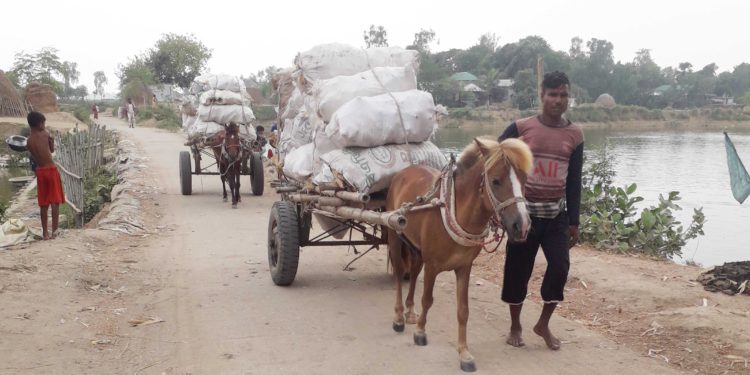Chalanbeel :: Chalanbeel is formed by rivers, canals and beels. The historical Chalanbeel of Bangladesh is well-known to the people of the whole country as a storehouse of grain and fish. The 9 Upazilas of Chalanbeel are Tarash, Ullapara, Shahjadpur, Faridpur, Bhangura, Chatmohar, Gurudaspur, Singra and Atrai. From ancient times to the end of the 20th century, the roads of Chalanbeel were unpaved, due to which bullock carts were in great demand, with the evolution of time, most of the roads in this area have been paved with the touch of modernity, as a result of which bullock carts are disappearing day by day.
As a result, horse-drawn carriages are easily available, now this vehicle is becoming popular in this area day by day. In ancient times, whenever you go out on the roads of the Chalanbeel area, you would see rows of cattle and buffalo carts, but now you can see horse-drawn carts. In those days, the only means of transportation and hope for people to travel from one place to another was the two-wheeled cattle and buffalo carts. Now, with the mechanical touch of modernity and the digital age, the ancient traditional cattle and buffalo carts and the profession of cart drivers of rural Bengal have almost disappeared and are under threat. The value of this slow-moving vehicle has decreased compared to before. Now, the value of horse-drawn carts has increased.
More than 2.2 million people live in the entire Chalanbeel area. When you search for information on the spot, you can see that some horse-drawn carts are being loaded with sacks of corn. There, we spoke to Md. Abdul Alim (45), a horse-drawn cart driver. He said that nowadays, the people of this area are using horse-drawn carts more instead of bullock carts for transporting all kinds of agricultural goods.
Because the fare of horse-drawn carts is lower than that of bullock carts, horse-drawn carts have become popular in this area day by day. He told this reporter with great sincerity that now, as the festival of corn and paddy harvesting and threshing is going on, they are earning an average of 1500/- to 2000/- taka from this cart every day, excluding all kinds of expenses. Agricultural workers load the goods on the horse-drawn carts. In addition, when the goods are low, the cart drivers themselves load the goods on the carts.
Although the roads have improved a lot in most places of the Chalanbeel area, due to the lack of good facilities for the movement of engine-driven vehicles, two-wheeled horse-drawn carts are being used to transport all kinds of goods. In modern civilization, the traditional ox-buffalo carts are disappearing, while horse-drawn carts are gaining popularity. The advantage of the popular horse-drawn cart in today’s society is that it does not require any fuel oil and the risk of serious accidents is much lower. This cart does not produce any smoke, does not harm the environment, and does not cause noise pollution. It is an environmentally friendly vehicle. Horse dung is used as organic fertilizer in villages and towns and as fuel for all cooking. With the changing times, the popularity and demand for the popular horse-drawn carts in the Beel area is increasing day by day. In ancient times, families that had horses were highly valued in society.
During the field investigation, we spoke to Md. Dulal Hossain, a buffalo driver in Kohit Tetulia village of Tarash upazila. He told this reporter with great respect that the value of our cars and income have also increased due to the introduction of various types of modern engine-driven vehicles in the market and the paving of rural roads and ghats. When I spoke directly to Dr. Md. Aminul Islam, the Tarash Upazila Animal Resources Officer, in this regard, he said with great sincerity that this horse-drawn carriage currently plays an important role in transporting all goods in the Chalanbeel area, and if anyone needs horse breeding and any treatment for horses, they will be provided with all possible assistance. #03.05.2025
Mirza Abdur Rob Bulbul




















